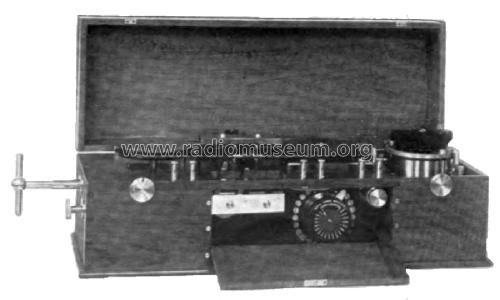Time Signal Receiver
Marconi's Wireless Telegraph Co. Ltd.
- Pays
- Royaume Uni
- Fabricant / Marque
- Marconi's Wireless Telegraph Co. Ltd.
- Année
- 1914
- Catégorie
- Module radio avant 1926 (pas un composant ni clavier)
- Radiomuseum.org ID
- 323001
- Gammes d'ondes
- Bandes en notes
- Tension / type courant
- Solaire ou/et mécanique
- Haut-parleur
- - Pour casque ou amplificateur BF
- Matière
- Boitier en bois
- De Radiomuseum.org
- Modèle: Time Signal Receiver - Marconi's Wireless Telegraph
- Forme
- Modèle de table boitier avec vouvercle
- Dimensions (LHP)
- 22.5 x 7.25 x 8.25 inch / 572 x 184 x 210 mm
- Remarques
-
The Marconi Time-Signal Receiver used as a chronometer as a navigational aid, clock to watch makers and to astronomers by receiving signals from the Time Signal Service.
It is an entirely self-contained apparatus, the detector, tuning condenser and inductor being mounted in the same case.
The magnetic detector consists of a soft iron band moving at a uniform rate in the magnetic field provided by two permanent magnets ; this band Passes through a glass tube carrying a primary winding connected to the aerial circuit through terminals, while a secondary winding connected to the headgear telephones is carried on an ebonite bobbin placed over the centre of the primary.
The band is composed of a large number of strands of fine gauge silk-covered soft iron wire, loosely twisted together, and covered with Vaseline ; it passes as an endless band round two ebonite pulleys-one driven by clockwork in the base of the instrument, and the other running free.
The arrangement of primary and secondary windings with their corresponding terminals is duplicated on the receiver, so that in the event of damage to the windings on one side the opposite set. can be employed.
A hinged lid is fitted on the case to protect the band, windings and other external parts from dust or breakage.
The aerial tuning inductance comprises a solenoid winding of insulated wire with tapping’s leading to a controller switch with 21 contacts, giving a wide range of finely graduated adjustment. The tuning condenser is of the disc pattern, giving continuously variable adjustment over the range of capacity required.
The method of connecting and using the instrument is very simple. Lt is necessary to point out that the receiver should not be connected directly to the aerial when the aerial is also being used for transmitting; in such cases it should be connected by a suitable switch.
The range of wave-length received on this instrument is approximately from 100 to 2,500 metres, but the limits of this range will vary with the aerial installed, the minimum wave-length received by the detector being a little more than half the fundamental wave-length of the aerial.
- Littérature
- -- Original prospect or advert (The Wireless World, Feb 1914, Page 686)
- Auteur
- Modèle crée par Gary Cowans. Voir les propositions de modification pour les contributeurs supplémentaires.
- D'autres Modèles
-
Vous pourrez trouver sous ce lien 94 modèles d'appareils, 92 avec des images et 17 avec des schémas.
Tous les appareils de Marconi's Wireless Telegraph Co. Ltd.
